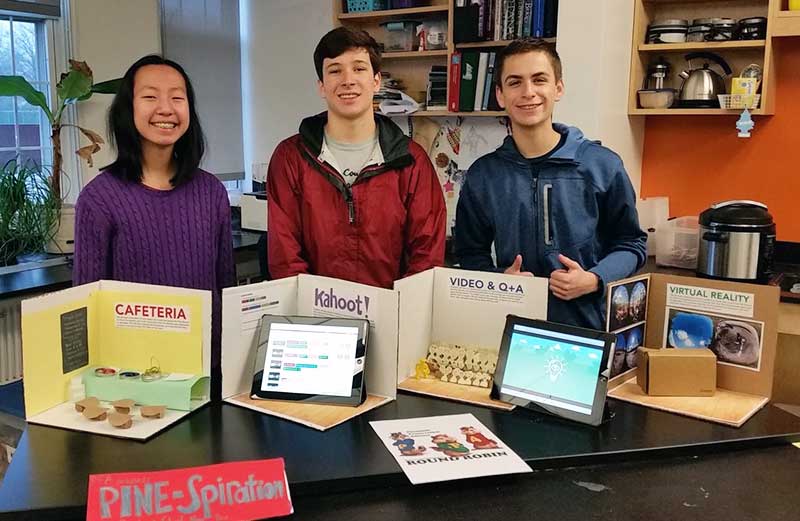By Andrew Rowan ’19, Marketing and Communications Student Intern
Drowning in post-it notes, magic markers, play-doh, Lincoln logs, and more, a group of students spent their Intensive Learning week thinking about real issues using a problem solving technique called “Design Thinking.”
“[Design Thinking] focuses on innovation, creativity, empathy, and teamwork,” reads the program description. Students follow the DEEPdt process of discover, empathize, experiment, and produce. Students went through this process in a “flash lab,” doing each step in just a few hours. This allowed the group to get a feel for what they would be doing for the next week, just on a bigger scale.
Enjoying the first flash lab of #DesignThinking at @mfsfox #IL2017 pic.twitter.com/K98YTrH8Wf
— Andrew Rowan (@andrewrowan128) March 24, 2017
“Design thinking is a creative, iterative problem solving process,” said French Teacher Scott Kelly, who, alongside Assistant Teacher John Trunkwalter, led the Design Thinking program. The group of 16 freshmen and sophomores partnered with the Pinelands Preservation Alliance (PPA). Their task: design an actionable solution to stop illegal ATV riders from damaging the natural habitats of the Pinelands.
Divided into three subgroups, the Thinkers spent the beginning of the week conducting interviews with various staff members from the PPA and surveying damaged areas. The Design Thinking process heavily relies on users’ input and feedback.
Our panel is fantastic and kids are asking insightful questions! #designthinking #il2017 #mfsil @PinesAlliance @mfsfox pic.twitter.com/OpYjvOqAs6
— Scott (@sublimescottie) March 27, 2017
After the interviews, students returned to campus to clearly define the problem. A full day of endless post-it notes, crayons, silly putty, and more were scattered across a science classroom as the three groups worked to come up with possible solutions, known as “low-resolution” prototypes.
#designthinking workshop at MFS @mfsfox: #Prototyping & #iteration after feedback from users & a surprise audience.https://t.co/k4z2hAfmwM pic.twitter.com/V2wvBxqfr0
— Scott (@sublimescottie) March 29, 2017
“This program gave us the opportunity to utilize our creativity, rationale, and empathy towards a real-world problem being faced in the Pinelands,” said sophomore Mariana Goldlust.
After students received feedback on their low-resolution prototypes from the staff at the PPA, they went through another round of reworking their ideas. This constant feedback loop and reworking of ideas allows for a polished, satisfying “high-resolution” prototype to be delivered to the user.
Students presenting and getting feedback on their prototypes. @mfsfox #designthinking @PinesAlliance #mfsil #il2017 pic.twitter.com/GWwBW2WzPV
— Scott (@sublimescottie) March 29, 2017
On a damp Friday morning at the PPA’s office in Pemberton, New Jersey, students presented their idea. One group suggested a highly interactive, round-robin assembly. This would showcase all the important foods the Pinelands provides, fun facts, and use 360 degree photos combined with Virtual Reality to bring the gravity of the damage to schools. The next group suggested a social media campaign called #TakeBackThePines, where users could sign petitions and rally their friends to encourage people to stop the illegal riding. Finally, the last group suggested the implementation of natural barriers such as trees and leaves to physically stop riders.
Design Thinking all set up to present their "Round Robin Assembly" prototype to @PinesAlliance today. #MFSIL pic.twitter.com/Mf4TkEW7hM
— Andrew Rowan (@andrewrowan128) March 31, 2017
Another great presentation for our partners at the @PinesAlliance #designthinking @mfsfox #il2017 #mfsil pic.twitter.com/G3ldoNQELC
— Scott (@sublimescottie) March 31, 2017
Final presentation at the @PinesAlliance for our partners. #designthinking #deeperlearning @mfsfox #mfsil #il2017 pic.twitter.com/mMk5Qa74DP
— Scott (@sublimescottie) March 31, 2017
“I think students have a better sense of their strength and weaknesses in group projects, and if they were to do this again, they would have a good sense about what they would do again and what they wouldn’t do,” said Mr. Kelly.
“Design thinking not only allowed me to expand and diversify my leadership abilities, but it also allowed me to step out of my comfort zone when finding new and interesting ways to find solutions to problems,” said sophomore Liam Schenk. Sophomore Cameron Stirner added that it “challenged me to think far outside the box, and empathize with those around me in everyday life.”
Jason Howell, Stewardship Coordinator at the Pinelands Preservation Alliance added, “The students involved in the intensive learning program took ownership over the issue that was presented to them. Instead of engaging superficially, these students sought to deeply understand the competing factors, limitations, and opportunities in order to synthesize that information into a strongly coherent strategy. The combined group proposals formed a potent initiative that has real potential to substantially solve both the short and long-term issues associated with the issue presented. I could not recommend the group and the program more strongly.”

